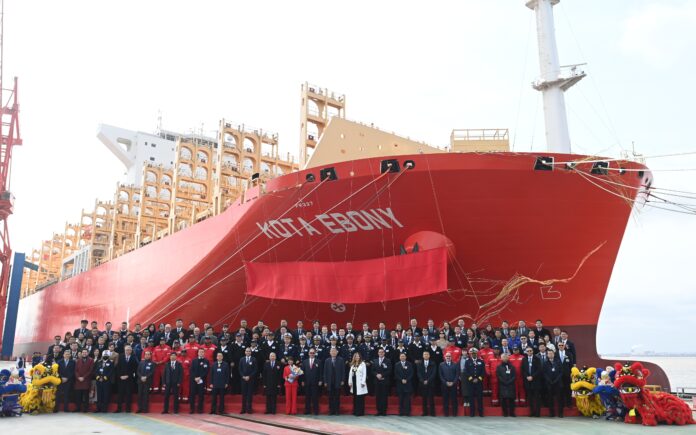Pacific International Lines (PIL) has taken delivery of its third 14,000 TEU LNG dual-fuel container vessel, named Kota Ebony. The naming ceremony was held at Jiangnan Shipyard in Shanghai, with Giselle Kastrup, wife of PIL CEO Lars Kastrup, officiating the event.
Part of a series of 14,000 TEU vessels, Kota Ebony boasts an optimized hull design and substantial reefer capacity, making it well-suited for the Latin American trade. The vessel also features advanced technologies, including high-performance anti-fouling coating to enhance fuel efficiency, exhaust gas recirculation systems to reduce methane emissions from the main engine, and improved data connectivity to bolster operational safety and efficiency.
Since 2022, PIL has ordered a total of 18 newbuild vessels, including four 14,000 TEU ships, as well as four 8,000 TEU, five 13,000 TEU, and five 9,000 TEU vessels.
Lars Kastrup commented: “We are thrilled to welcome Kota Ebony, our third 14,000 vessel to our fleet. These efficient dual-fuel vessels enable us to further bolster our services and support the growing trade between China and Latin America. The first two sister ships, Kota Eagle and Kota Emerald, were delivered in October and December last year, and are already operating successfully on our Latin America service network. We are now proud to add Kota Ebony to reinforce the East Coast Latin America service.”
As the third of four 14,000 TEU vessels designed and built by Jiangnan Shipyard, one of China’s premier shipbuilders, Kota Ebony is now one of the largest vessels in PIL’s fleet and among the first to operate on Liquefied Natural Gas (LNG), underscoring the company’s commitment to sustainable shipping.
Lars Kastrup added: “Our fourth 14,000 TEU vessel is expected in the coming months and will be joined by another 14 dual-fuel, biomethane-capable vessels which will be delivered progressively over 2025 and the subsequent years. This significant investment represents PIL’s ongoing efforts at fleet renewal as well as our unwavering commitment to making shipping more environmentally sustainable as we chart our way to achieve net zero emissions by 2050.”







